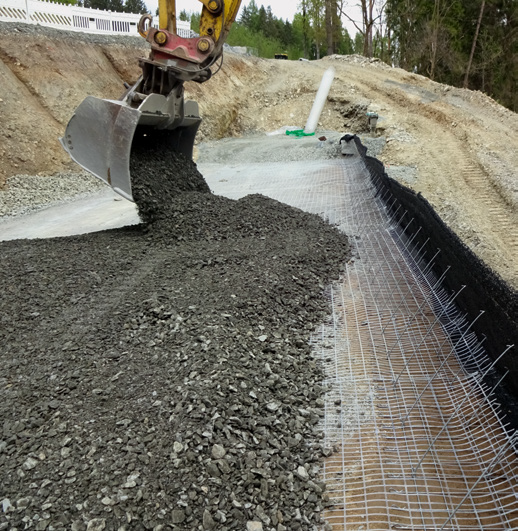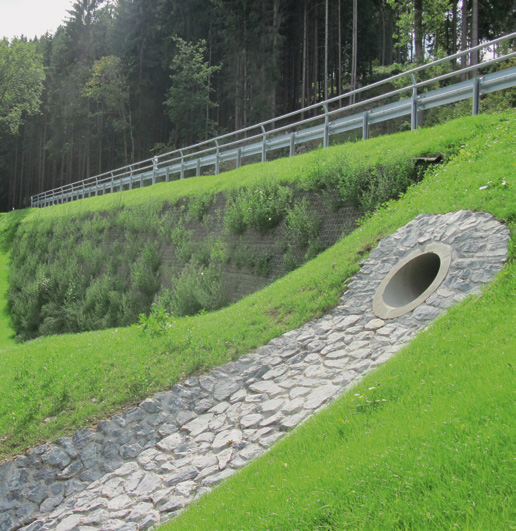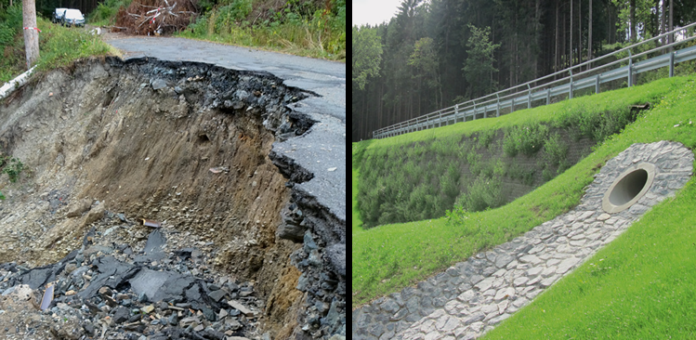Composite reinforcement systems that combine geosynthetics with different facing systems and supports (steel mesh, soil anchors, etc.) have grown substantially in use. These systems enable very efficient construction of slopes, walls, and embankments, including at significant angles. Where older infrastructure has suffered, it has become more common to see these newer reinforcement designs utilized for reconstruction.
NAUE’s Steel P system, which was used to rebuild a roadway embankment in Germany following a heavy storm, exemplifies this movement in the field.
NOTE: This project was originally profiled in NAUE News 49 (PDF).
MORE NAUE: 850 Geotextile Bags Protect Historic Scottish Golf Course
ROADWAY EMBANKMENT FAILURE & RECONSTRUCTION
Heavy rain destroyed a road in Adorf-Freiberg in the Vogtland region. It was the sort of extreme weather event that has been experienced far more frequently as the impact of climate change has been more greatly felt. Up to 150 liters of rainwater fell in just one hour. The storm’s greatest damage was felt in Adorf-Freiberg.

A culvert along the city’s Leubethaer Straße could no longer handle the enormous quantity of water. Water began to accumulate inside the roadway embankment, as fines from the soil fill washed out. Abruptly, the undermined roadway embankment gave way.
The slope side slipped completely across a length of 30m.
The state of Saxony recognized the event as a sign of greater problem than a single event. The failure was seen as a sign of potential future risk from climate change-related extreme weather occurrences. Significant financial support was then provided by the state to ensure that the local municipality and related roadway agencies understood they would be supported in executing these projects with an eye to preventing future failures.
As such, a geosynthetic-reinforced system was designed into the roadway embankment repair.
The system selected was a geogrid-reinforced mechanically stabilized earth (MSE) wall system. The strategy, combined with a steel mesh facing as part of the system, allowed the road embankment to be safely rebuilt with a slope inclination of 70° across a 54m length.

NAUE Secugrid® geogrids were used for the reinforcement. The facing system (NAUE Steel P) consisted of galvanized steel grid elements that were adapted to the shape of the embankment. The steel grid element was connected to the horizontal Secugrid® geogrid reinforcement by friction.
A total of 11 geogrid layers of Secugrid® 80/20 R6 in combination with Secugrid® 40/20 R6 were installed for the maximum structure height of 7.7m. Each geogrid layer was anchored up to 7m into the embankment, covered with 500mm fill soil each and compacted.
To prevent soil erosion at the embankment front, a Secumat® erosion protection mat was installed between the steel grid element and the fill soil.
The three-dimensional mat also supported the subsequent greening of the roadway embankment surface so that the MSE wall blended perfectly into the existing landscape.
In total 475m² of Secugrid® 80/20 R6, 1,425m² of Secugrid® 40/20 R6, and 240m² of Secumat® were installed.

THE TAKEAWAY
The MSE solution, which utilized a composite reinforcement system, provided an economical and ecological rehabilitation. It also provided an exemplary approach to better defending Saxony’s infrastructure against future extreme weather events.
PROJECT CREDITS
The project was planned by Ökoplan Bauplanung GmbH, Plauen. UTR Umwelt-, Tiefbau und Recycling GmbH, Schönbrunn/Vogtland, was the general contractor. The installation on site was carried out by GGS TerraCon GmbH, Moritzburg.
Learn more about NAUE Steel P, Secugrid®, and other geosynthetic applications, engineering strategies, and materials at www.naue.com.












